Nordic Curls
Nordic Curls: A How-To Guide
The Hamstring Muscles
The Hamstrings are a group of three muscles (Bicep femoris: long and short head, semitendinosus, and semimembranosus) at the back of the thigh with attachments at the bottom of your pelvis (ischial tuberosity) and the two bones in your lower leg (tibia & Fibula).
The hamstring muscles cross two joints (knee & hip) and as a result, are responsible for movement at both of these joints, including flexing the knee and extending the leg at the hip.
Hamstring Injuries
Hamstring Injuries are a common and recurrent injury in athletes and sports (requiring frequent high-speed movements). These injuries commonly occur when the hamstring muscles are maximally lengthened (knee completely extended and hip flexed). For example, sprinting and kicking.
Injuries to the hamstrings occur when their eccentric strength does not meet the demands of the sport or activity. Following a hamstring injury, most athletes will require time off in their sport to rehabilitate the hamstrings. This can take between 2-3 months depending on the type and severity of the injury
Nordic Curl and Injury Prevention
Due to the mechanism of injury (correlation between eccentric strength & sports demand), it is clear eccentric hamstring strength is an important consideration in a strength program for injury prevention. The Nordic Curl is a highly regarded eccentric hamstring strengthening exercise. It is found as a staple in an athlete’s exercise program due to its association with injury prevention.
Research has shown the Nordic Curl has the potential to reduce the rate of hamstring injury by up to 51%. Similarly, the Nordic Curl has been shown to increase eccentric hamstring strength by 10-26% and fascicle length by 12-22.
While the Nordic Curl is a great exercise for both strength & preventing injuries, it is an advanced exercise and can be difficult for many individuals to complete. Below are our go-to exercises. They can be used as a starting point to build up your eccentric hamstring strength in a less demanding environment. You can begin with exercise 1 and gradually progress to each exercise as your hamstrings begin to get stronger.
1. Banded Nordic Curl Rollout with Swiss Ball
The Banded Nordic Curl Rollout will be the easiest of these 4 exercises and will be a good starting point before moving on if you have never attempted Nordic Curls before.
-
Assume the starting position with a swiss ball in front of you and your legs anchored or someone holding them down. Place a band around your chest.
-
While holding onto the swiss ball slowly lower your body down controlling the movement with your hamstrings as much as you can.
-
Once you reach your end range of motion, roll back up using the swiss ball whilst bringing yourself to the start position.
-
Ensure you keep your body as straight as possible and control the movement with your hamstrings, this is an eccentric strengthening exercise of the hamstrings.
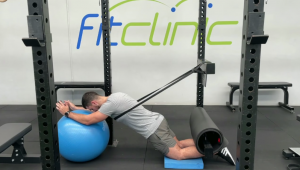
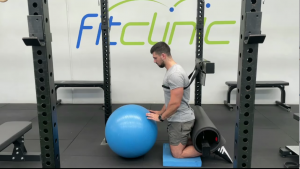
2. Nordic Curl Rollout with Swiss Ball
Once you feel comfortable completing the Banded Nordic Curl Rollout, you can remove the band (this will increase the demand of the exercise and provide less support) and complete the Nordic Curl Rollout as described above.
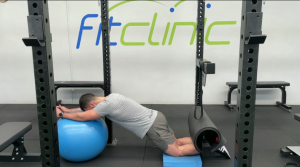
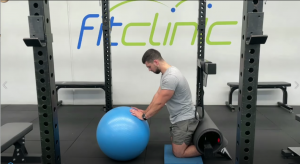
3. Banded Nordic Curl with Bosu Pushup
Following on from the Nordic Curl Rollout exercise is the Banded Nordic Curl with Bosu Push up. This exercise will remove the constant support in the ascending and descending phases which is provided by the swiss ball and will require more focus on the eccentric contraction of the hamstring (the band will still provide support in the lower phase).
-
Assume the starting position with a bosu ball in front of you and your legs anchored or someone holding them down. Place a band around your chest.
-
Slowly lower your body down to the bosu ball (or soft surface) infront of you, controlling yourself as much as you can.
-
Once reaching the bottom, push yourself up and return to the start position.
-
Ensure you keep your body as straight as possible and control the movement with your hamstrings, this is an eccentric strengthening exercise of the hamstrings.
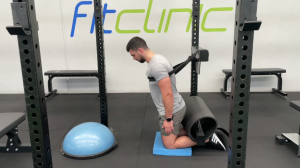

4. Nordic Curl with Bosu Pushup
Similar to how you increased the demand of the rollout exercise, you can remove the band from the above exercise to increase the demand of the activity by decreasing the support for the eccentric contraction. Ideally, during this exercise you will not have any support during the eccentric (lowering phase) of the Nordic Curl. The movement will be controlled by the strength of your lengthening hamstrings and you will use the bosu ball to push your body back to the start position as you did in the above exercise.
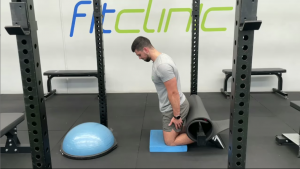

References
Alnonso-Fernandez, D., Docampo-Blanco, P., & Martinez-Fernandez, J. (2017). Changes in muscle architecture of biceps femoris induced by eccentric strength training with nordic hamstring exercise. Scand J Med Sci Sports, 28,88-94
Grando, M., & Dressendorfer, R. (2020). Hamstrin Strain. Cinahl Information Systems.
Lategan, L., & Gouveia, C. P. (2018). Prevention of hamstring injuries in sport: a systematic review. South African Journal for Research in Sport, Physical Education and Recreation, 40(1),55-69.
Medeiros, D. M., Marchiori, C., & Baroni, B. M. (2021). Effect of nordic hamstring exercise training on knee flexors eccentric strength and fascicle length: a systematic review and meta-analysis, 30,482-491.
van Dyk, N., Behan, F. P., & Whiteley, R. (2019). Including the Nordic hamstring exercise in injury prevention programmes halves the rate of hamstring injuries: a systematic review and meta-analysis of 8459 athletes. British journal of sports medicine, 53(21), 1362–1370.
